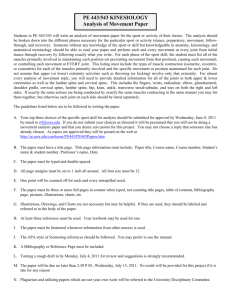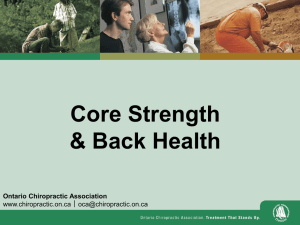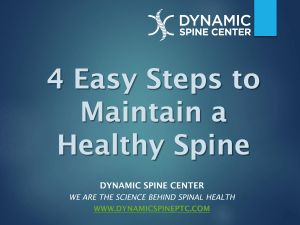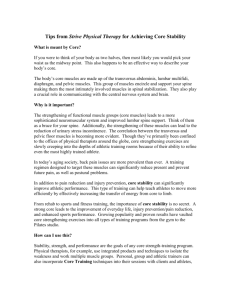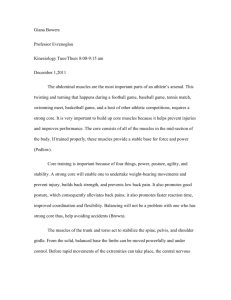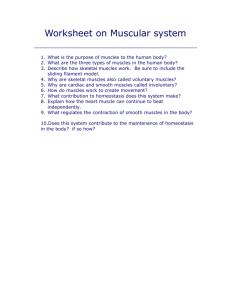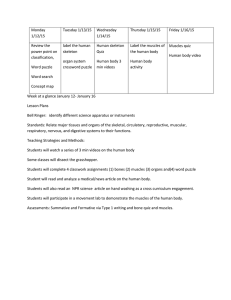5. Core Muscles of the Trunk
advertisement
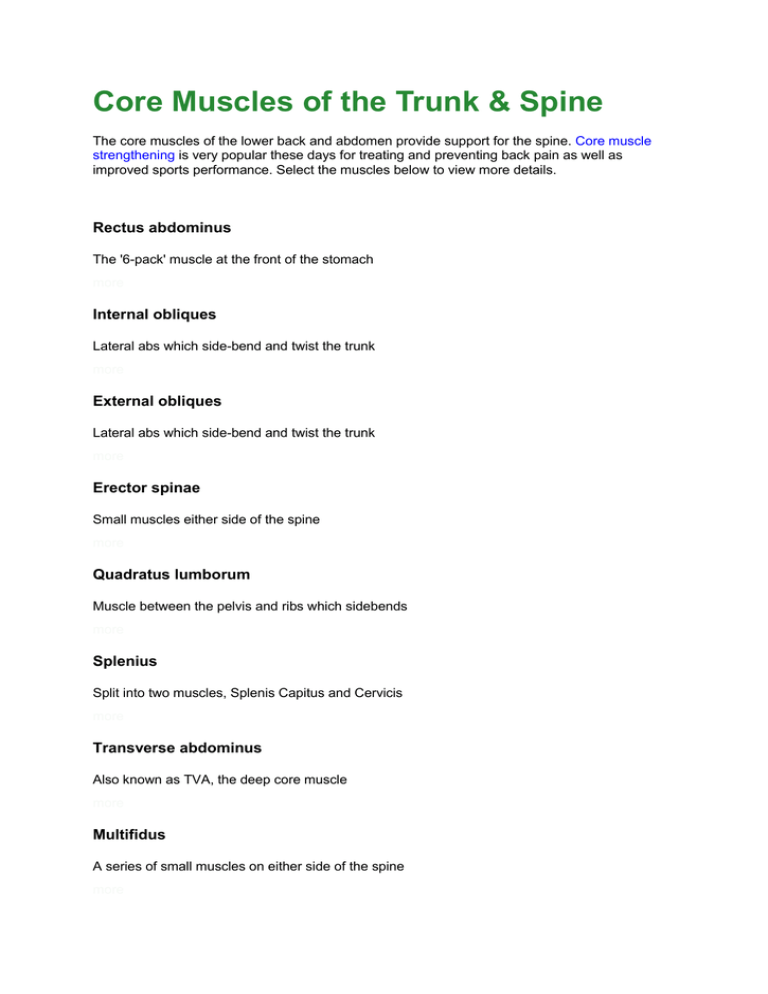
Core Muscles of the Trunk & Spine The core muscles of the lower back and abdomen provide support for the spine. Core muscle strengthening is very popular these days for treating and preventing back pain as well as improved sports performance. Select the muscles below to view more details. Rectus abdominus The '6-pack' muscle at the front of the stomach more Internal obliques Lateral abs which side-bend and twist the trunk more External obliques Lateral abs which side-bend and twist the trunk more Erector spinae Small muscles either side of the spine more Quadratus lumborum Muscle between the pelvis and ribs which sidebends more Splenius Split into two muscles, Splenis Capitus and Cervicis more Transverse abdominus Also known as TVA, the deep core muscle more Multifidus A series of small muscles on either side of the spine more The Main Core Muscles The largest muscle of the trunk and spine is the errector spinae muscle which extends all the way up the back of the spine. Other large muscles involved in moving and supporting the spine are the large abdominal muscles, internal and external oblique muscles and the quadratus lumborum muscles. A number of smaller muscles are also involved which attach to the spine. Rectus Abdominis Rectus Abdominis is the most superficial of the abdominal muscles. It is this muscle which forms the six-pack shape! Origin Crest of the pubis. Pubic symphesis. Insertion Xiphoid process (base of the sternum). 5th,6th and 7th costal cartilages. Actions Flexes lumbar spine. Innervation Ventral rami of thoracic nerves. Daily uses Moving from lying to sitting. Example strengthening exercises Crunches or sit-ups. Example stretches Abdominal stretch. Related injuries Abdominal strain. Related muscles Internal obliques. External obliques. External Obliques The obliques wrap around the trunk on each side to form our waists and join to the linea alba, a band of connective tissue running down the front of the abdomen. They help us to side bend and rotate the body. Origin Lowest 8 ribs. Insertion Front 1/2 of the iliac crest. Linea alba. Actions Contraction of one side alone laterally bends the trunk to that side and rotates the trunk to the other side. Compresses the abdomen and supports the abdominal viscera. Innervation Ventral rami of thoracic nerves. Daily uses Raking leaves. Example exercises Twisting crunches. Related injuries Abdominal strain. Related muscles Internal obliques. Rectus abdominus. Quadratus Lumborum The quadratus lumborum or QL is a common cause of back pain which is to one side and comes on after lifting or twisting. Origin Posterior iliac crest. Iliolumbar ligament. Insertion Twelfth rib. Transerve processes of L1-L4. Actions Lateral flexion (side-bends) of the trunk. Innervation Ventral rami of the subcostal nerve. Lumbar nerves. Daily uses Bending sideways to pick something up. Example strengthening exercises Side bends. Related injuries Hyperlordosis. Related muscles Internal obliques. External obliques. Transversus Abdominis Transversus Abdominis is often abbreviated to TVA. This is a very important core muscle which is vital in maintaining good posture. Activities such as Pilates focus on contraction of the TVA. Origin Front of the iliac crest. Inguinal ligament. Costal cartilages of the lower 6 ribs. Thoracolumbar fascia. Insertion Linea alba. Actions Compresses the abdomen and supports the abdominal visera. Innervation Ventral rami of thoracic nerves. Ilioinguinal nerve. Iliohypgastric nerve. Daily uses Maintaining good posture. Example exercises Core contraction exercises. Related injuries Lower back pain. Related muscles Rectus abdominis. Internal Obliques The internal obliques wrap around the waist and insert into the linea alba, a cord like strip of connective tissue running down the centre of the abdomen. They help to side bend and twist the body Origin Iliac crest. Inguinal ligament. Thoracolumbar fascia. Insertion Lower 3-4 ribs. Linea alba. Actions Contraction of one side alone laterally bends the trunk to that side and rotates the trunk to the other side. Compresses the abdomen and supports the abdominal viscera. Innervation Ventral rami of thoracic nerves. Ilioinguinal nerve. Iliohypgastric nerve. Daily uses Raking leaves. Example strengthening exercises Twisting crunches. Related injuries Abdominal strain. Related muscles External obliques. Rectus abdominus. Erector Spinae The erector spinae (sometimes known as sacrospinalis) is often described as a group of different muscles called iliocostalis, longissimus and spinalis. Erector spinae consists of lots of small fibres which are situated very close to the spine. Origin Posterior crest of the ilium. Lower posterior surface of the sacrum. Lower 7 ribs. Spinous processes of T9-L5. ransverse processes of T1-12. Insertion Angles of the ribs. Transverse processes of all vertebrae. Base of the skull. Actions Extension of the spine. Lateral flexion (side-bending) of the spine. Maintains correct curvature of the spine. Innervation Dorsal rami of cervical, thoracic and lumbar spinal nerves. Example strengthening exercises Dorsal raises. Example stretches Back arch stretch. Related injuries Lower back pain. Related muscles Multifidus. Multifidus Multifidus is a series of small muscles which travel up the length of the spine. It is an important muscle in the rehabilitation of Gilmore's Groin and lower back pain. Origin Posterior surface of the sacrum. Articular processes of the lumbar vertebrae. Transverse processes of the thoracic vertebrae. Articular processes of C3-7. Insertion Each part of the muscle inserts into the spinous process 2-4 vertebrae higher than its origin. Actions Extension. Lateral flexion. Rotation of the spine. Innervation Dorsal rami of the spinal nerves. Daily uses Maintaining good posture of the spine. Example strengthening exercises Dorsal raises. Example stretching exercises Back arch stretch. Related injuries Lower back pain. Related muscles Erector spinae.

